Avoided Emissions
The Taisei Group aims to contribute to reducing society's CO2 emissions through the Group's technologies and solutions.
For Environmentally Friendly Design (Including ZEB), Green Renewal ZEB and T-Green® Multi Solar, we have calculated the avoided emissions, which indicates how much the use of our products and services contributes to reducing CO2 emissions in society overall, based on the GX League's "Basic Guidelines for Disclosure and Evaluation of Climate-related Opportunities."(*1)
Calculation results
(unit: t-CO2)
| Target product/service (technology) | Avoided emissions that are estimated from design and construction in FY2022 (*2) |
|---|---|
| 1. Environmentally Friendly Design (Including ZEB) | 567,482 |
| 2. Green Renewal ZEB | 10,006 |
| 3.T-Green® Multi Solar | 1,530 |
- *1 The avoided emissions are calculated as the difference between the greenhouse gas emissions of existing products and services (baseline) and those of new products and services, and refers to new products and services that contribute to the mitigation of climate change (impacts) in society overall (GX League, "Basic Guidelines for Disclosure and Evaluation of Climate-related Opportunities".) The avoided emissions of "Environmentally Friendly Design (Including ZEB)", "Green Renewal ZEB" and "T-Green® Multi Solar" overlap somewhat.
- *2 The avoided emissions are calculated from the assumption that duration of operation will continue based on the service life, etc. (the calculation method is mentioned below.)
1.Environmentally Friendly Design (Including ZEB)
CO2 emissions from the operational phases of buildings such as homes and office buildings account for about one-third of Japan's total emissions. Especially in office buildings, where lighting and air conditioning consume more than half of the energy used, energy-saving measures are urgently needed.
To address this challenge, the Taisei Group is promoting energy-saving designs from the planning and design stages of buildings, thereby working to reduce CO2 emissions during the operational phases of the buildings.
In addition to office buildings, we are also promoting the ZEB (net Zero Energy Building) transformation of various industrial buildings, including factories, and the ZEH (net Zero Energy House) transformation of condominiums and private residences, as part of the full-scale decarbonization that will be required in the future.
| Product / service(technology) that contributes to reduction | Environmentally Friendly Design (Including ZEB) |
|---|---|
| Qualification | Achieving reductions in CO2 emissions through energy-saving design, resulting in lower BEI values 【Energy-saving technologies examples】 https://www.taisei-techsolu.jp/solution/se_saving/ https://www.taisei-techsolu.jp/solution/sol_environment/sol_environment_01.html This system achieves energy savings by controlling individual lights with optimum luminance by detecting whether people are present or not. 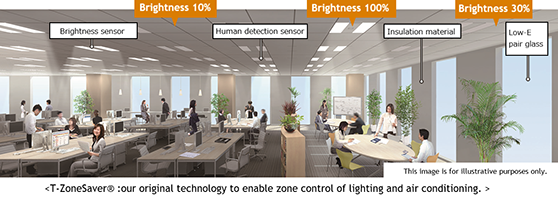 T-Light®Blind Daylighting Device This new type of blind simultaneously allows for daylighting and shading, which brings natural light deep into the room, improving comfort and energy efficiency. 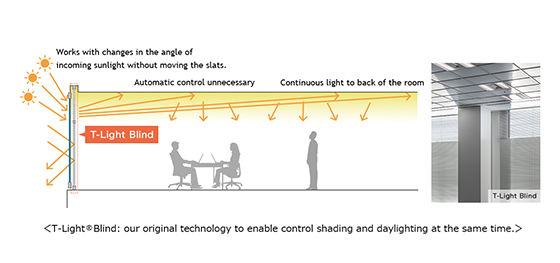 |
| Calculation method |
Baseline CO2 emissions − CO2 emissions from our design projects CO2 emissions from our design projects = Total floor area of our design projects × CO2 emission factor× CASBEE service life ★Baseline: Total floor area of our design projects × CO2 emission factor (assuming BEI = standard for energy-saving law compliance) × CASBEE service life |
| Possible negative effects | None |
| Third-party certification | None |
Construction example
Taisei Corporation ZEB Demonstration Building (Human Space Lab)
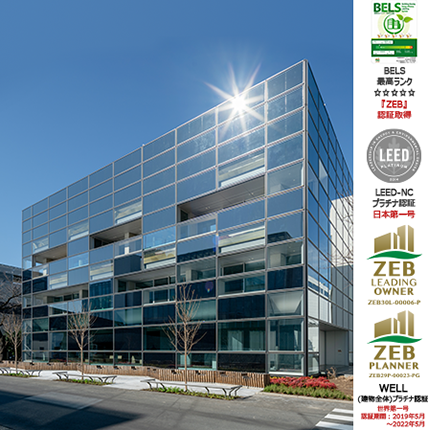
| Location | Inside Taisei Advanced Center of Technology (Totsuka-ku, Yokohama, Kanagawa Prefecture) |
|---|---|
| Completion | Constructed: May 2014 Renovated: February 2020 |
| Structure | Structure Reinforced concrete structure (seismic isolation structure), 3 floors above ground, 1 rooftop floor Floor area 1,277 m2 |
| Type of ZEB | ZEB: Over 100% energy reduction |
| Other | Ministry of the Environment "2013 Low Carbon Technology Research and Development Program" |
2. Green Renewal ZEB
In Japan, the total floor area of new buildings built in a year accounts for only about 1% of the total buildings in Japan. Therefore, as a measure toward achieving carbon neutrality, it is essential to renovate existing buildings into buildings with low environmental impacts. The Taisei Group actively promotes converting existing buildings into ZEBs through our Green Renewal ZEB initiative.
| Product/service (technology) that contributes to reduction | Green Renewal ZEB Initiative to renovate existing buildings into ZEBs (Net Zero Energy Buildings) https://www.taisei-techsolu.jp/solution/ct_renewal/zeb_zeb.html 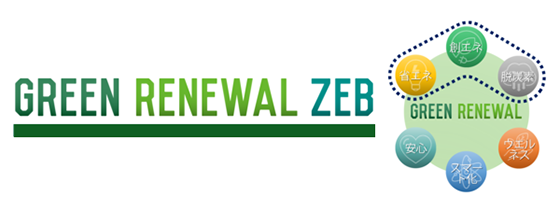 |
|---|---|
| Qualification | Reduce CO2 emissions in existing buildings through energy-saving by improved thermal insulation, energy-saving high-performance equipment, energy-saving systems, and so forth, and energy creation by installing solar panels. |
| Calculation method | (CO2 emissions of existing building / year − CO2 emissions after renewal / year) × 20 years (assumed number of years of operation after renewal) − CO2 emissions from renewal construction ★Baseline: CO2 emissions of existing buildings  |
| Possible negative effects | None |
| Third-party certification | None |
| Future goals | 240,000 t (FY2030) 720,000 t (FY2050) |
Construction example
Kansai Branch (ZEB Ready)
~Practicing Advanced + General-Purpose ZEB Technology to Meet Diverse Client Needs~
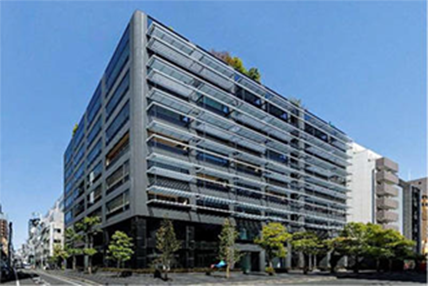
| Location | Chuo-ku, Osaka-shi, Osaka |
|---|---|
| Completion | 1992 (first built) / 2023 (Green Renewal ZEB) |
| Structure | Reinforced concrete, 2 basement floors / 9 floors above ground, total floor area of 13,700 m2 |
| Type of ZEB | ZEB Ready acquired (BEI = 0.37) |
| CO2 emissions | Reduction of 365 t of CO2 / year (reduction rate: 52.7%) |
| Utility bills | Reduction of 17.6 million yen / year (reduction rate: 44.3%) |
3. T-Green® Multi Solar
Medium-rise and high-rise buildings in city centers have small rooftops often filled with various MEP equipments. Therefore it is impossible to secure space for the installation of photovoltaic panels.
By sandwiching solar cells between laminated glass, the building's exterior itself, such as the walls and windows, becomes a power generation system, thereby facilitating efficient solar power generation.
In addition, since the building itself has a self-sustaining power supply, it can use electricity even in the event of a power outages.
| Product / service (technology) that contributes to reduction | “T-Green® Multi Solar” A glass-integrated power generation system with a high-quality design that effectively utilizes the exterior of a building (walls and window surfaces) to generate solar power. https://taisei-techsolu.meclib.jp/techsol_320/book/#target/page_no=3 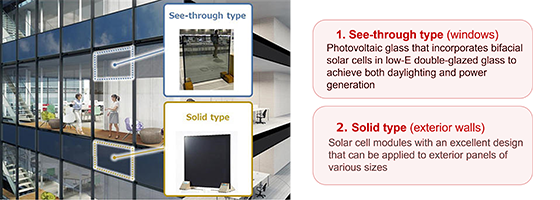 |
|---|---|
| Qualification | Reduce buildings' CO2 emissions by generating energy using the exterior walls and windows, which was not possible before. |
| Calculation method | (Estimated power generation calculated from the installation area × CO2 reduction effects) × 30 years (power generation warranty period) CO2 reduction effects are based on the labeling guidelines of the Japan Photovoltaic Energy Association. ★Baseline: No T-Green® Multi Solar installation (building with no exterior power generation)  |
| Possible negative effects | None |
| Third-party certification | None |
| Future goals | 340,000 t (FY2030) |
Construction example
Furubira Municipal Complex “Kanaeru”
| Location | Furubira-gun, Hokkaido |
|---|---|
| Completion | February 2022 |
| Structure | Reinforced concrete, 3 floors above ground, total floor area of 3,806 m2 |
| Type of ZEB | ZEB Ready acquired (BEI=0.49) |
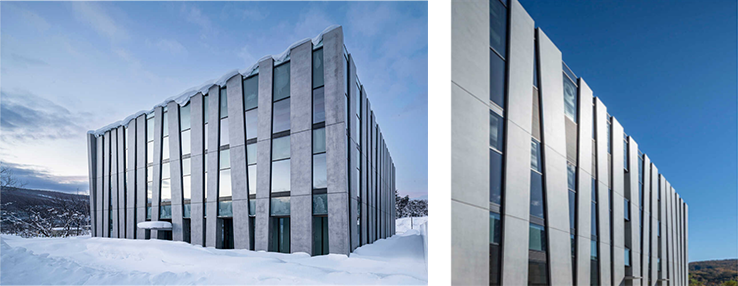
See-through types of non-standard sizes are installed on the southeast and southwest windows.
The main government office building is a ZEB complex that integrates passive technologies, such as exterior insulation and natural ventilation, with a combination of various active technologies, such as a HP system and earth tubes that utilize the geothermal heat peculiar to Hokkaido. The see-through type is used on the southeast and southwest sides, and together with the solar cell modules at the top of the disaster prevention building, it has a power generation capacity of 26 kW and a storage battery with a capacity of 24 kWh. In addition to an emergency generator that can operate for 72 hours, this disaster-resistant government building fully implements BCP measures.
